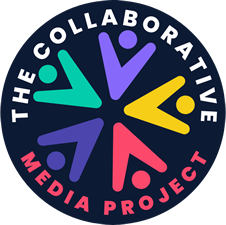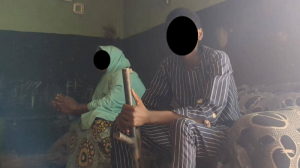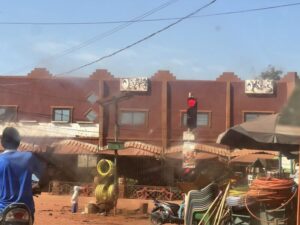At first glance, Usman looks like any other infant, wrapped in a shawl, lying on a bed at Gombe Specialist Hospital. But this six-month-old, weighing just 3.1kg, is fighting for his life due to severe malnutrition. His mother, Zainab Umaru, watches over him, her face full of worry. Usman was born healthy, but his health began to decline when he was four months old.

“There was no breast milk from his mother, and he became very thin. We were referred to the Specialist Hospital from Kalshingi, and they put him on a special diet. We are trying our best to buy the food, but it is difficult because of the economy,” his grandmother Ladi Shuiabu explains.
Nearby, 17-month-old Nafisa, weighing only 5.5kg, is also battling malnutrition. Her mother, Aisha Samaila, shares their struggle: “Doctors say my daughter is anaemic and has malaria. She’s had three blood transfusions. Life is tough, I can only feed her moi moi (bean cake) or awara (made from soya beans) sometimes. My husband, who used to be a driver, has no job now. Feeding is a big problem for us.”
Not far away, Amina lies motionless, tubes attached to her weak body. Her mother, Maryam Usman Hussaini, shares their hardship: “We often have just one meal a day usually rice or tuwo. My daughter needs proper food, but I’m also sick, and my husband has already spent N40,000 on my treatment.”
 Alhassan Yahya, Nutrition Champion
Alhassan Yahya, Nutrition ChampionFive-year-old twins, Hassana and Hussaina, from Tudun Wadan Pantami weigh only 8.7kg, which is closer to the weight of a toddler. Their mother, Aishatu Ibrahim, struggles to provide for them.
“Sometimes, they went days with only water when they were with their grandmother. Now they are with me, but I still can’t meet their needs with the little I earn from making bags.
They were weak and couldn’t talk at five, but with help from kind people, they are slowly recovering. We still need more support.”
Malnutrition is often a cycle passed from mother to child, as seen in families like that of Malam Adam Mohammed in New Liji. His wife, malnourished during pregnancy, gave birth to an underweight baby.
“Before the fuel subsidy removal, we had three meals a day, but now we eat only what we can afford. I had to take my daughter to a clinic in Borno State for treatment when there was no therapeutic food in Gombe.
 Comfort Mukollo, CS-SUNN Coordinator Gombe State
Comfort Mukollo, CS-SUNN Coordinator Gombe StateHe explained that economic hardship plays a significant role in the malnutrition crisis and that removal of the fuel subsidy in Nigeria has increased the cost of living, putting nutritious food further out of reach for many families like his.
Plenty food on the table yet Malnourished Children
In Dogon Ruwa, a farming village, known for its large-scale farming, where crops like maize, rice, and vegetables grow in plenty, malnutrition has shocked families like those of Alhaji Shehu Ibrahim and Ibrahim Abubakar, despite having plenty of food.
“My three-month-old daughter was malnourished, but after treatment with special food, she got better. We have enough food, but maybe we do not know the right way to eat,” says Shehu.
“I have a daughter who was healthy but later started losing weight. People said it was due to her mother’s breast milk. She was diagnosed with malnutrition, and we were advised to improve her diet. I started adding fish and other nutrients to her meals, and now she is responding well. Food is truly not our problem here. We are into large scale farming,” Abubakar adds.
Understanding the Crisis
A dietitian, Abigail Yohannah, explains that many families are affected by “hidden hunger,” where their food lacks the essential nutrients needed for growth and health.
“A balanced diet is one that provides all the essential nutrients your body needs to function properly. This includes carbohydrates for energy, proteins for growth and repair, fats for brain and cell function, as well as vitamins and minerals like iron and calcium for overall health. It’s important to consume a variety of foods from different food groups, such as fruits, vegetables, whole grains, lean proteins, and healthy fats. Without this balance and adequacy, especially in children, growth can be stunted, and cognitive development impaired, leading to long-term health challenges,” Yohannah explains.
 Dr Kelechi Ebisike, Consultant Pediatrician, FTH Gombe
Dr Kelechi Ebisike, Consultant Pediatrician, FTH GombeDr Kelechi Ebisike, a paediatrician at the Federal Teaching Hospital Gombe, also points out that “malnutrition isn’t just about being underweight. It’s about lacking the nutrients children need to grow and learn.
On the other hand, overnutrition happens when there’s an excessive intake of calories or nutrients, leading to overweight, obesity, and related health risks like diabetes and heart disease, Dr Kelechi explains.
The Data Behind the Crisis
Gombe State’s Community-Based Management of Acute Malnutrition (CMAM) programme recorded 14,175 cases of severe malnutrition in 2020, with 50 deaths.
Across Nigeria, UNICEF estimates that 11 million children are affected by food poverty. Without help, children like Hassana and Hussaina, the twins, face a 50% higher risk of severe malnutrition, which weakens their immune systems and makes them more vulnerable to diseases. This is more than just a health crisis; it is a food inequality crisis that threatens to create a generation of children who may never reach their full potential, according to experts.
Nigeria, according to UNICEF, has the second-highest burden of stunted children in the world, with a national prevalence rate of 32% of children under five. Stunting refers to a child who is too short for his or her age.
According to the National Food Consumption and Micronutrient Survey 2024 report, wasting affects one out of every ten children in Nigeria.
A WHO report dated 1st March 2024 indicated that globally in 2022, 149 million children under five were estimated to be stunted, 45 million were wasted, and 37 million were overweight or living with obesity.
 Preventive food distribution
Preventive food distribution
Consequences of Malnutrition
Malnutrition not only stunts physical growth but also impacts learning and emotional development. Experts warn that if the situation is not urgently addressed, the long-term impact on Gombe’s future workforce and leadership could be catastrophic.
“Malnutrition has devastating, lifelong impacts on children. In its most severe form, it impairs brain development, affecting not just physical health but also cognitive abilities, learning, and educational outcomes. Malnourished children are predisposed to infections, such as tuberculosis and pneumonia. Addressing malnutrition isn’t just about feeding children; it’s about securing their future potential,” explains Dr Ebisike.
Dr Sagir Mohammed, a Consultant Obstetrician and Gynaecologist at the Specialist Hospital Gombe, also highlights the maternal link to the problem.
“Malnourished mothers often give birth to malnourished children, creating a dangerous cycle that spans generations. Without proper nutrition, these mothers face complications during pregnancy, such as anaemia, and their children are born with health challenges that can last a lifetime.”
Alhassan Yahya, a nutrition champion, notes that malnourished individuals may be more susceptible to antisocial behaviours due to their inability to access formal or religious education. “Research I conducted revealed that many individuals involved in banditry, terrorism, and kidnapping have a history linked to malnutrition. This lack of education and opportunity can push them towards criminal activities,” he says
Poverty, food scarcity, and limited access to nutrition education are major causes of malnutrition, according to Gombe State Nutrition Officer, Mrs Ronas Amusa, and the Gombe State Coordinator of Civil Society Scaling Up Nutrition in Nigeria (CSSUNN), Mrs Comfort Mukollo.
“With so many needs and limited resources to satisfy, a farmer, for instance, is often forced to sell his farm produce after harvest to pay for school fees, house rent, and other basic needs. As a result, he may not have enough money left to buy all the classes of food required to provide a balanced diet for his family,” Mukollo explained.
“One significant cause of malnutrition is the lack of nutrition awareness. Many people have access to all classes of food but lack the knowledge on how to combine them for a balanced diet. For example, some communities grow maize, millet, vegetables, and fruits and rear animals for meat and dairy, covering all major food groups. However, due to limited understanding of nutrition, they may not know how to combine these foods to ensure a diet rich in all essential nutrients. Without this knowledge, malnutrition persists even among those with abundant food resources.”Amusa added.
Gombe State Government’s Efforts
The Gombe State government has made efforts to combat this crisis. Their nutrition interventions focus on prevention, therapeutic food distribution, and educating families, as explained by Mrs Ronas Amusa.
“The state government pays counterpart funds to UNICEF to purchase Ready-to-Use Therapeutic Food (RUTF) as a curative measure and to ANRIN for the prevention of malnutrition. Another prevention programme operates in 153 communities across Kaltungo, Dukku, and Kwami, providing small nutrient supplements for moderately malnourished and healthy children. We also encourage and support families to grow and consume orange-fleshed sweet potatoes to get vitamin A and iron, and to sell the excess to meet other needs. Additionally, we run food and nutrition demonstration programmes, enlightening women on how to grow and use locally available food,” explains Amusa.
Civil Society Organisations Initiatives
The Civil Society Scaling Up Nutrition in Nigeria (CSSUNN), comprising over ten civil society organisations, has undertaken various initiatives to combat malnutrition in Gombe State.
These activities, according to the Gombe State Coordinator, Mrs Comfort Mukollo, include food demonstration programmes during antenatal care (ANC) sessions to teach the preparation of balanced meals and the establishment of food and nutrition clubs in secondary schools.
“These efforts aim to ‘catch them young,’ helping students understand the importance of nutrition early in life.”
The CSSUNN has also conducted household sessions with women, encouraging them to embrace home gardening by using sacks, plastics, or backyard spaces to improve their families’ nutrition.
Mukollo emphasised, “We believe that
small-scale gardening can make a big difference in household food security. We have paid advocacy visits to traditional and religious leaders to urge them to use their platforms to preach the importance of exclusive breastfeeding,” Mukollo explained.
Mukollo said currently, CSSUNN is involved in a project supported by UNICEF, focused on preventive measures. One of the key advocacy points is the extension of maternity leave to six months to promote exclusive breastfeeding, along with the timely release of funds for nutrition programmes
The Path Forward
Nutrition Champion Alhassan Yahya, CSSUNN Coordinator Comfort Mukollo, Dietitian Mrs Yohannah, and Mrs Sarah Yapwa of the Hope for the Lonely Organisation outline potential solutions.
“The fight against malnutrition requires a collective effort from the government, community leaders, and religious leaders. The focus should be on prevention, such as promoting exclusive breastfeeding, nutrition education, complementary feeding, and micronutrient supplementation for children under five. It’s about empowering mothers with the right information and resources. For those already malnourished, treatment is paramount. The government should ensure timely release of funds for RUTF,” says Yahya.0
“To address malnutrition effectively, there is a need for sustained advocacy and government commitment, more job creation, skills acquisition programmes to address poverty. Communities should embrace home gardening. The Food and Nutrition Policy launched this year is a good approach by the Gombe government, but it should be fully implemented for it to be effective. adds Mukollo.
“A balanced diet is crucial for combating malnutrition. For instance, rice can be eaten with beans, vegetables, and a little oil all of which are locally grown in Gombe, avoid giving children just akamu” notes Yohannah.
Sarah Yapwa concludes, “To combat food insecurity, government must empower women farmers and support real farmers not political farmers to achieve bumper harvests. This is critical for ensuring everyone has access to nutritious food.”
Final Reflections
Food and nutrition inequality is a critical aspect of Sustainable Development Goal (SDG) 2: Zero Hunger, which aims to end hunger, achieve food security, improve nutrition, and promote sustainable agriculture. SDG 2 focuses on ensuring that all people, especially vulnerable groups, have access to safe, nutritious, and sufficient food year-round.
Time is running out, and without urgent action from policymakers, development agencies, and local communities, the silent suffering of families in Gombe will only grow louder, leaving children like Mohammed, Amina, Usman, Hassana, and Hussaina unable to reach their full potential. But through collective action, the cycle of food and nutrition inequality can be broken, and the future of these children can be rewritten. It is not just about feeding them today but securing their future tomorrow.
This report was facilitated by the African Centre for Development Journalism (ACDJ) as part of its 2024 Inequalities Reporting Fellowship, supported by the MacArthur Foundation through the Wole Soyinka Centre for Investigative Journalism.



